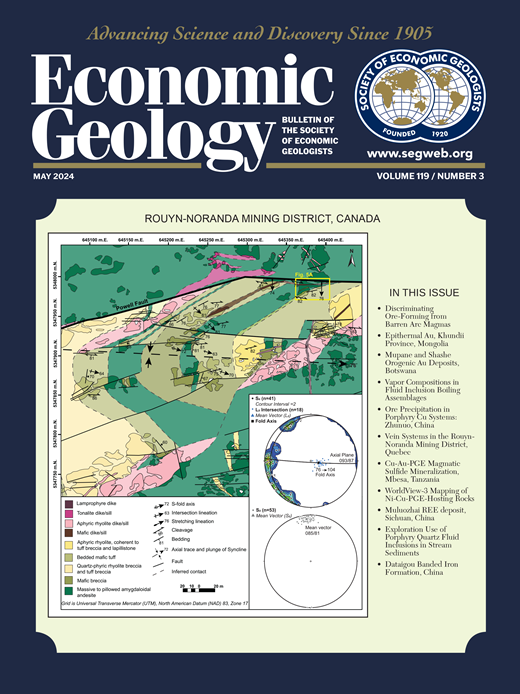智利中部 Río Blanco 铜-钼斑岩矿藏的地质与结构
IF 4.9
1区 地球科学
Q1 GEOCHEMISTRY & GEOPHYSICS
引用次数: 0
摘要
Río Blanco-Los Bronces 矿床是世界上含铜金属量最大的铜-钼斑岩矿床。它是岩浆活动和热液活动长期叠加的产物,与多次侵入和角砾岩事件有关,并同时伴有区域隆升、侵蚀和解顶以及减压。岩浆活动导致了三个主要的矿化-蜕变阶段。前矿化阶段发生在旧金山浴成岩的形成过程中,导致了晚期岩浆活动和早期热液活动。同步矿化阶段与 Río Blanco-Los Bronces 斑岩和砾岩复合体相关的主要热液事件相对应,这些热液事件与三个侵入阶段、广泛的砾岩和表生型高级箭石蚀变有关。晚期岩浆活动之后的热液活动与次火山流纹岩复合体和晚期斑岩侵入体的形成有关。同步矿化侵入体与高品位角砾岩体有关,这些角砾岩体具有明确的蚀变-分带模式。 通过对来自不同矿山、隧道和矿坑的历史 Río Blanco 构造数据集进行汇编和分析,可以根据其连续性、横切关系和填充成分将所有绘制的构造划分为四个等级。较大的结构(阶次 0 和 1)具有沿矿脉的连续性,在掘进巷道和/或矿层之间具有相关性,而较小的结构(阶次 2 和 3)则根据其尺寸和在较大阶次结构定义的板块内的分布情况进行分组。所有 0 级和 1 级构造均为三维建模,2 级和 3 级构造为二维建模。在 Río Blanco 绘制的结构与岩浆作用和矿化的前期到后期地质演变有着密切的关系。区域尺度的构造演化与成矿前的盆地开辟和随后的构造反转有关,其次是地区尺度的构造演化与成矿前的盆地开辟和随后的构造反转有关,而在营地尺度上,成矿同期至后期的侵入体和相关的热液特征叠加在这一继承的构造结构上。本文章由计算机程序翻译,如有差异,请以英文原文为准。
Geology and Structure of the Río Blanco Cu-Mo Porphyry Deposit, Central Chile
The Río Blanco-Los Bronces deposit is the largest Cu-Mo porphyry deposit in the world in terms of contained Cu metal. It is the product of protracted superposed magmatic and hydrothermal activity associated with multiple intrusive and brecciation events, with simultaneous regional uplift, erosion and unroofing, and decompression. Magmatism resulted in three major mineralization-alteration stages. The premineralization stage occurred during the emplacement of the San Francisco batholith, resulting in late magmatic and early hydrothermal events. The synmineralization stage corresponds to the main hydrothermal events associated with the Río Blanco-Los Bronces porphyry and breccia complexes, which were related to three intrusion phases, widespread brecciation, and an epithermal-style advanced argillic alteration. Late-stage magmatism, followed by hydrothermal activity, was associated with the emplacement of subvolcanic rhyolite complexes and late-stage porphyry intrusions. The synmineralization intrusions are associated with high-grade breccia bodies that have well-defined alteration-zonation patterns. Compilation and analysis of the historical Río Blanco structural data sets from the different mines, tunnels, and pits have allowed the assignment of all mapped structures to four hierarchical orders based on their continuity, crosscutting relationships, and infill compositions. The larger structures (orders 0 and 1) have along-strike continuity, correlate between drifts and/or mine levels, whereas smaller structures (orders 2 and 3) were grouped according to their dimensions and distributions within the larger-order structure-defined panels. All orders 0 and 1 structures were modeled in three dimensions, while orders 2 and 3 were in two dimensions. The structures mapped at Río Blanco have an intimate relationship with the pre- to the late-stage geologic evolution of magmatism and mineralization. The regional- and to a lesser extent district-scale structural evolution was related to premineralization basin-opening and subsequent tectonic inversion, whereas at the camp scale, syn- to late mineralization intrusions and related hydrothermal features were superimposed on this inherited structural architecture.
求助全文
通过发布文献求助,成功后即可免费获取论文全文。
去求助
来源期刊

Economic Geology
地学-地球化学与地球物理
CiteScore
10.00
自引率
6.90%
发文量
120
审稿时长
6 months
期刊介绍:
The journal, now published semi-quarterly, was first published in 1905 by the Economic Geology Publishing Company (PUBCO), a not-for-profit company established for the purpose of publishing a periodical devoted to economic geology. On the founding of SEG in 1920, a cooperative arrangement between PUBCO and SEG made the journal the official organ of the Society, and PUBCO agreed to carry the Society''s name on the front cover under the heading "Bulletin of the Society of Economic Geologists". PUBCO and SEG continued to operate as cooperating but separate entities until 2001, when the Board of Directors of PUBCO and the Council of SEG, by unanimous consent, approved a formal agreement of merger. The former activities of the PUBCO Board of Directors are now carried out by a Publications Board, a new self-governing unit within SEG.
 求助内容:
求助内容: 应助结果提醒方式:
应助结果提醒方式:


